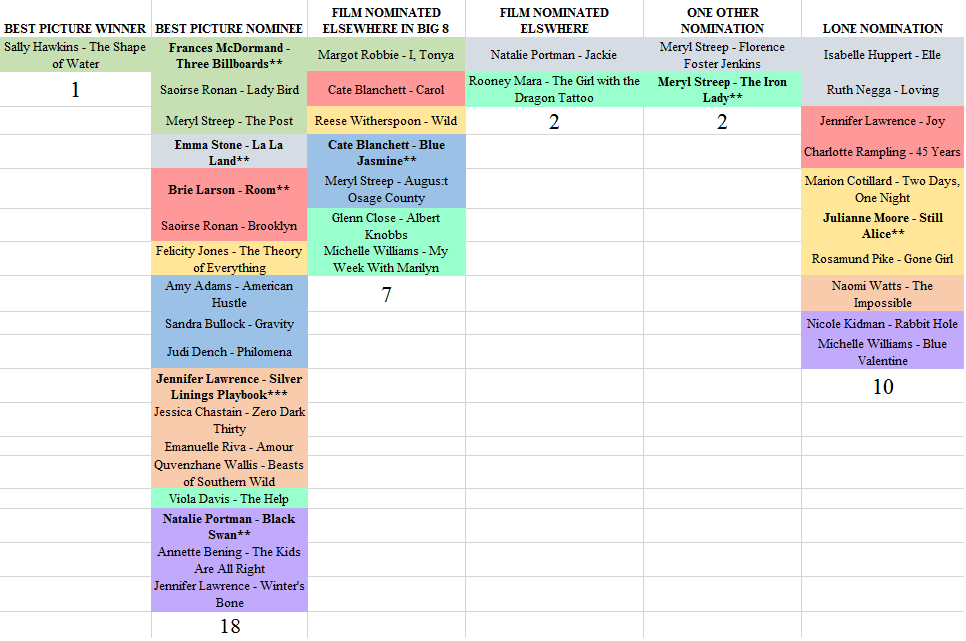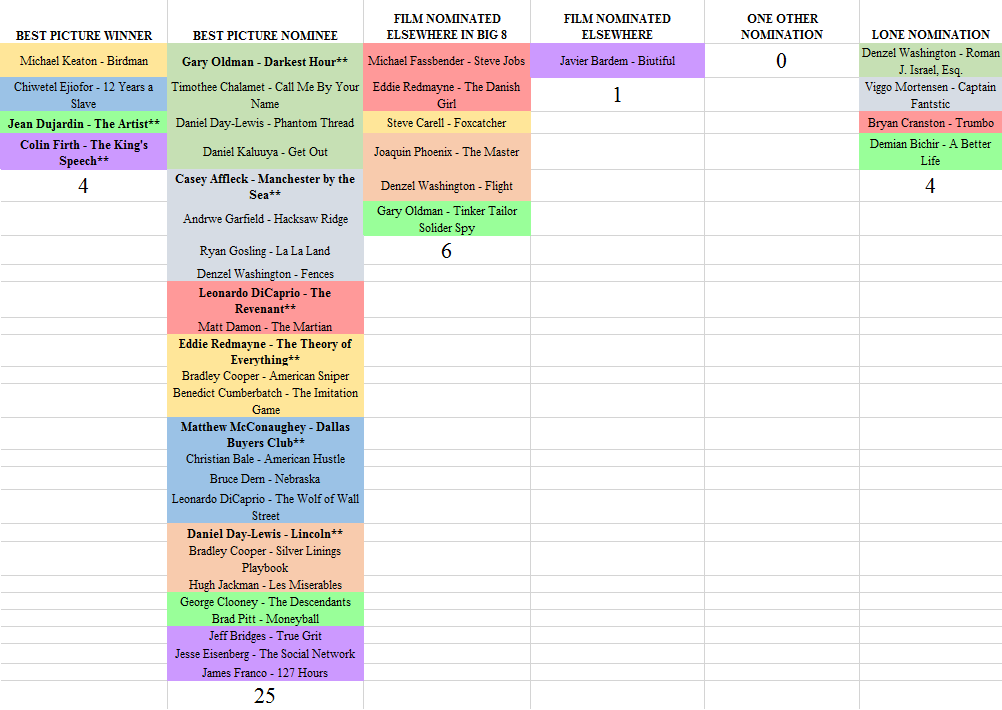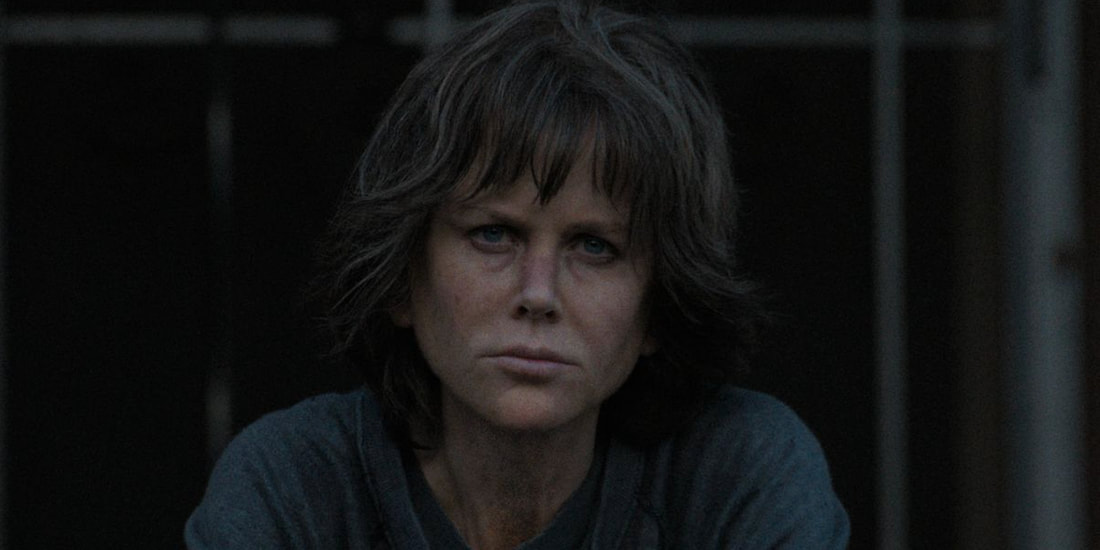Welcome to October, where for the next three months, there is going to be endless discussion of acting predictions and which actors are “in” and “out” and for what reasons. Pundits sometimes use the proximity of a performer’s film to Best Picture as a justification for predicting them in Best Actor and Best Actress. The logic is, having a Best Picture-contending film yields more advantageous results for lead actors and actresses from those films to be nominated independently for their work. For instance, one may have been more likely to predict Sally Hawkins to be nominated for “The Shape Of Water” at this time last year since that was a Best Picture frontrunner, rather than predicting Jessica Chastain for “Molly’s Game” which was not getting as much Best Picture buzz. It is a stat that is used as a tool for constructing an argument.
Another common justification cited to support acting predictions is, using the number of possible nominations a film could receive overall as a reason to predict an actor from that film to nominated. An example is Ryan Gosling in “La La Land” having a better chance of being nominated for Best Actor than Joel Edgerton for “Loving,” since the former film was going to receive nominations across the board and the latter would only receive the bare minimum. This is an assumption that if a film is plentifully nominated, it indicates a consensus approval for a film, even though that isn’t rooted in fact: each branch votes individually for their respective categories and one branch may feel passion for a film while another may not.
Pundits also have a habit of dismissing a performer’s chances due to the possibility that they would be the only nomination for their film. The contention follows logically enough, but there is a sexist blind spot to this argument of predictions: Best Actress contenders are consistently more likely to be in under-nominated films and non-Best Picture movies than Best Actor contenders. Due to the patterns of the types of films the Academy nominates for Best Picture and in most categories – the Academy always more heavily represents films with male protagonists than female ones – these arguments put Best Actress performances and predictions at a systematic disadvantage and, I would argue, even skew predictions.
Take a look at the recent history of Best Actor and Best Actress in the graphics below. I broke up the 40 nominees from each Best Actor and Best Actress since the beginning of this decade into six categories:
1. Nominees who were in Best Picture-winning films.
2. Nominees who were in Best Picture-nominated films.
3. Nominees who were in films that were not nominated in Best Picture, but received other nominations in the “Big 8” categories. (Acting, Screenplay, Director)
4. Nominees who were in films that received nominations in below-the-line categories. (Technical and Craft.)
5. Nominees who were one of two nominations for their films.
6. Nominees who were the only nomination for their films.
These results reveal a staggering statistic along with a gender divide. The Best Actor nominees were abundantly in films nominated for or that won Best Picture, whereas the same is not true of the Best Actress nominees. In fact, over half of the Best Actress nominees were in films that were not competing for Best Picture. To contrast, 75% of the Best Actor nominees were in Best Picture winners or nominees. A notable mention, too, is half of the Best Picture winners this decade also held a nomination for Best Actor. But only one film, “The Shape Of Water,” that won Best Picture featured a Best Actress nominee (or a female protagonist), out of eight films.
Even a worse discrepancy, 10 of the 40 Best Actress nominees so far this decade have been the sole nominations for their films (that’s about 25%), while only four of the 40 Best Actor nominees were the lone nominations for their films. Think about that: for every four performances nominated in Best Actress, one of them will be from a film nominated in no other category besides Best Actress.
Does this show that female-led stories are less respected by the Academy, or that the more interesting female characters that lead to Best Actress nominations are in “lesser” films? Even though last year was the best year of this decade in terms of statistics – the Best Actress nominees were comprised of one Best Picture winner, three Best Picture nominees, and a film that was nominated (and won) elsewhere in the Big 8 – the Academy has a problem on this front. The year before had only one Best Picture nominee nominated in Best Actress, three lone Best Actress nominees, and one Best Actress nominee with only below-the-line mentions.
These statistics are a reality we need to take into consideration when predicting both the nominees and winners of the top acting categories at the Oscars. As demonstrated, lone nominations are more common than one would think, and these solo Best Actress nominations are more highly frequent than in Best Actor. There are factors that make lone nominations more realistic: release date, reviews, outlier critical support, the reputation of the actor/actress themselves, politics of the moment, etc. In this awards season cycle, there are a few Best Actress-qualified performances in prominent films that will fill categories above and below the line. On the contrary, there are phenomenally received portrayals in contention for Best Actress that could end up being the sole nominations for their films.
Below are roughly the top eleven contenders for Best Actor and Best Actress thus far in the race. If the performance has asterisks ***, it indicates the film is in the hunt for a Best Picture nomination.
BEST ACTOR
If nominated, will be in a film that will have at least more than one nomination:
Christian Bale – “Vice” ***
Bradley Cooper – “A Star Is Born” ***
Clint Eastwood – “The Mule” ***
Ryan Gosling – “First Man” ***
Ethan Hawke – “First Reformed”
Lucas Hedges – “Boy Erased”
Rami Malek – “Bohemian Rhapsody”
Viggo Mortensen – “Green Book” ***
If nominated, could stand a good possibility at being the only nomination for his film:
Willem Dafoe – “At Eternity’s Gate”
Hugh Jackman – “The Front Runner”
Robert Redford – “The Old Man And The Gun”
BEST ACTRESS
If nominated, will be in a film that will have at least more than one nomination:
Yalitiza Aparicio – “Roma” ***
Olivia Colman/Emma Stone – “The Favourite” ***
Lady Gaga – “A Star Is Born” ***
Melissa McCarthy – “Can You Ever Forgive Me?” ***
Saoirse Ronan – “Mary Queen Of Scots”
If nominated, could stand a good possibility at being the only nomination for her film:
Glenn Close – “The Wife”
Toni Collette – “Hereditary”
Viola Davis – “Widows”
Felicity Jones – “On The Basis Of Sex”
Nicole Kidman – “Destroyer”
Julia Roberts – “Ben Is Back”
Immediately, there is an imbalance of contenders. The more than two-thirds of the Best Actor contenders stand a decent chance at their film being nominated elsewhere in the Academy, whether in above-the-line or below-the-line categories. It’s highly conceivable that all five Best Actor contenders come from the list of eight, and there will not be a lone nomination there. If there is one, my guess is it will be Hugh Jackman for “The Front Runner,” whose charisma could win over voters enough in FYC campaigning to cross the January finish line. Meanwhile, more than half of the Best Actress contenders (5 vs. 6) are in movies that are on the trajectory of being single-nomination films. I have serious doubts about Ronan’s chances for “Mary Queen Of Scots,” so even if the other four from the first list are nominated, there will likely be one nominee who is the sole nomination for her film.
In the second half of the list for Best Actress, there are some fierce contenders. Glenn Close is the one with the highest profile at this point because “The Wife” has already released theatrically. She has ardent supporters who are banging on the Oscar drum for the veteran actress to finally receive her overdue Academy Award. Some people call this Close’s career-crowning work, conveniently forgetting “Dangerous Liaisons” and “Fatal Attraction” still exist. “The Wife” premiered before phase one of the season began, and the film itself is not of sterling quality, so it may not have the legs to outrun performances with primetime release dates and better films. There is no doubt that if Close is nominated, she will be the only nomination for her film. Many have tried to compare Close in “The Wife” to Julianne Moore in “Still Alice,” while ignoring the fact that the latter is a supremely better film that had a proper awards season release date. Even if she does make the Academy shortlist, a win is far from guaranteed now that Lady Gaga’s revelatory performance in “A Star Is Born” has roared off screens and Melissa McCarthy is attracting momentum for “Can You Ever Forgive Me?,” Close’s overdue narrative might not even work if she manages to squeak into the top five.
On a hot-streak recently from her Emmy wins for “Big Little Lies” and an Oscar nomination for “Lion” two years ago, Nicole Kidman is getting some of the greatest critical citations of her career for Karyn Kusama’s “Destroyer.” Her work has been called a tour de force on multiple occasions. The biggest hurdle for Kidman is that her film is a controversial genre picture and it’s dividing viewers right and left. Though it’s been reviewed as having a memorable original score and Kidman’s character’s look could enter the Best Makeup & Hairstyling race (which is an odd category, with a strange system and isn’t reliably predictable), Best Actress is most likely the only possible nomination for “Destroyer.” Kidman has already begun campaigning and has a release date on Christmas Day that is optimal for buzz peaking at the right time as Oscar voting begins. What Academy member won’t be in the Nicole Kidman spirit after reading the reported rave review of the film from Manohla Dargis’ in The New York Times on Christmas morning? Dargis has previewed her take on “Destroyer” after Toronto in a recap, calling Kidman “sensational,” and sources say she loved the film.
Some may be taken aback when they see I listed Viola Davis as a lone nomination possibility. I categorized her as such due to the fact that no one has a firm grasp on what the hell is actually going on with “Widows.” It doesn’t safely fit into the top five predictions of any category; everything is a risk or a bet at this point. The film was well-received out of Toronto, but at the same time, demoted to more of a “commercial film” and not something that will be up the alley of the Academy. No nomination is certain, yet it could be a massive hit and get several mentions from different branches of the Academy. It’s all about the way it sticks the landing. But there’s a world where her notoriety and intense acting sensibilities guide Viola Davis to a Best Actress nomination while the rest of “Widows” is forgotten.
An interesting precedent for both Kidman and Davis being lone nominations for their films is Rosamund Pike’s nomination for “Gone Girl.” Maybe it’s not a specifically apt comparison since “Gone Girl” was predicted for several categories, such as Best Picture, Best Film Editing, Best Original Score, and many believed it would actually win Best Adapted Screenplay. Neither “Widows” nor “Destroyer” have that kind of traction. However, many attribute its lack of Oscar success to the genre and commercial traits in the identity of “Gone Girl.” When people doubt the Academy appeal of each of this year’s films, it’s the genre of “Destroyer” and commercial aspect of “Widows.” “Gone Girl” did get a nomination for Best Actress, therefore it’s possible Kidman or Davis could undergo the same treatment as Pike. Heck, this could even apply to Toni Collete in “Hereditary,” which is arguably the most superbly reviewed performance of the year. Her problem is deeper because the horror genre bias is three times more arduous to surmount than simply the dark thriller genre partiality Kidman and Davis are facing.
Felicity Jones’ take on Supreme Court Justice Ruth Bader Ginsberg in “On The Basis Of Sex” is beginning to stand out to me as a contender with each passing day. The film’s trailer was met with negative reactions, but the film will open the AFI Film Festival. Jones will enter the conversation, under the contingency that the film is decent, if for no other reason but the role itself, and even if she’s not nominated, she may be in the mix in a similar way as Michelle Williams was in “All The Money In The World” last year, due to her release date.
The final potential lone nomination contender worth mentioning is Julia Roberts in “Ben Is Back.” Her place in the race is tricky. On the one hand, Roberts is one of the most iconic movie stars of our time, is no stranger to the Academy (four nominations with one win), and has respectable reviews for her new film. On the other hand, the lukewarm and uneven response for the film itself will probably foil her chances. The recently released trailer for “Ben Is Back” illuminates some of the discussion around her performance. It highlights Roberts’ best qualities as an actress: character intensity and screen power. However, it also looks to showcase her worst qualities: ostentatious overacting and desperation to work with mediocre writing.
To forecast my instincts about how this year will fit into the overall trend of lone Best Actor and Best Actress nominations, this year may not be as harsh as other years we have seen earlier this decade. Best Actor will likely maintain its consistency of nominating performances in Best Picture contenders or more high-profile projects. Jackman is the only real lone nominee possibility in that race, and that’s only if an incredible campaign is run for him.
Continuing from last year’s more gender-neutral results, I imagine we will see an above average amount of Best Actress contenders who are in Best Picture nominees or highly nominated films. Best Actress has three solid spots claimed right now with Lady Gaga, Melissa McCarthy, and Olivia Colman. And all three are in films that have a likely chance of being nominated for and potentially winning Best Picture. Aparicio looks to be in good shape for another film that will get many Big 8 nominations with “Roma,” but there is a chance she doesn’t make the leap from festival darling to in industry awards magnet. A non-professional newcomer in a foreign language film, using a naturalistic style of acting is not the easiest sell, despite how well Netflix is using public relations to gain exposure for Aparicio.
There will be at least one, if not two, Best Actress nominees who are the only nomination from her film. That leaves at least one spot for Close, Kidman, Davis, Collette, Roberts and Jones to wrestle over. One thing is for certain: Best Actress will either have the same amount or more lone nominees than Best Actor, keeping with the overall trend of the decade, despite progress being made.
My Current Predictions For Best Actress & Best Actor…
BEST ACTRESS
Glenn Close – The Wife
Olivia Colman – The Favourite
Lady Gaga – A Star Is Born
Nicole Kidman – Destroyer
Melissa McCarthy – Can You Ever Forgive Me?
BEST ACTOR
Christian Bale – Vice
Bradley Cooper – A Star Is Born
Hugh Jackman – The Front Runner
Clint Eastwood – The Mule
Viggo Mortensen – Green Book
What do you think? Will there be lone nominations for Best Actor and Best Actress this Oscar cycle? What are your current predictions? Let us know in the comments section below.
You can follow Ryan and hear more of his thoughts on the Oscars and Film on Twitter at @RyanCShowers





